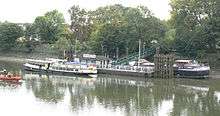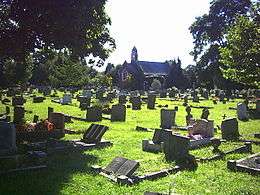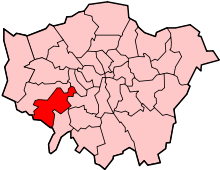Kew
Kew (/kjuː/) is a district in the London Borough of Richmond upon Thames, 1.5 miles (2.4 km) north-east of Richmond[2] and 7.1 miles (11.4 km) west by south-west of Charing Cross; its population at the 2011 census was 11,436.[1] Kew is the location of the Royal Botanic Gardens ("Kew Gardens"), now a World Heritage Site, which includes Kew Palace. Kew is also the home of important historical documents such as Domesday Book, which is held at The National Archives.
| Kew | |
|---|---|
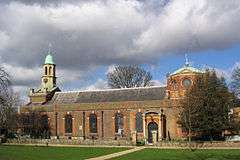 Parish Church of St Anne, Kew | |
 Temperate House in Kew Gardens | |
 Kew Location within Greater London | |
| Area | 3.30 km2 (1.27 sq mi) |
| Population | 11,436 2011 Census (Kew ward 2011)[1] |
| • Density | 3,465/km2 (8,970/sq mi) |
| OS grid reference | TQ195775 |
| London borough | |
| Ceremonial county | Greater London |
| Region | |
| Country | England |
| Sovereign state | United Kingdom |
| Post town | RICHMOND |
| Postcode district | TW9 |
| Dialling code | 020 |
| Police | Metropolitan |
| Fire | London |
| Ambulance | London |
| UK Parliament | |
| London Assembly | |
Julius Caesar may have forded the Thames at Kew in 54 BC during the Gallic Wars.[3] Successive Tudor, Stuart and Georgian monarchs maintained links with Kew. During the French Revolution, many refugees established themselves there and it was the home of several artists in the 18th and 19th centuries.
Since 1965 Kew has incorporated the former area of North Sheen[4] which includes St Philip and All Saints, the first barn church consecrated in England.[5] It is now in a combined Church of England parish with St Luke's Church, Kew.
Today, Kew is an expensive residential area because of its suburban hallmarks. Among these are sports-and-leisure open spaces, schools, transport links, architecture, restaurants, no high-rise buildings, modest road sizes, trees and gardens. Most of Kew developed in the late 19th century, following the arrival of the District line of the London Underground. Further development took place in the 1920s and 1930s when new houses were built on the market gardens of North Sheen and in the first decade of the 21st century when considerably more river-fronting flats and houses were constructed by the Thames on land formerly owned by Thames Water.
Etymology
The name Kew, recorded in 1327 as Cayho, is a combination of two words: the Old French kai (landing place; "quay" derives from this) and Old English hoh (spur of land). The land spur is formed by the bend in the Thames.[6]
Governance
Kew forms part of the Richmond Park UK Parliament constituency; the Member of Parliament is Sarah Olney. For elections to the London Assembly it is part of the South West London Assembly constituency.
Kew was added in 1892[7] to the Municipal Borough of Richmond which had been formed two years earlier, and which was in the county of Surrey. In 1965, under the London Government Act 1963, the boundaries of Greater London were expanded to include Kew which, with Richmond, transferred from Surrey to the new London Borough of Richmond upon Thames.
Economy
.jpg)
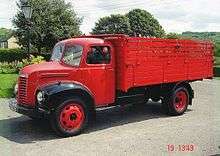
.jpg)
The fashion clothing retailer Jigsaw's headquarters are in Mortlake Road, Kew.[8]
A former industry in Kew was that of nameplate manufacturing, by the Caxton Name Plate Manufacturing Company, based on Kew Green. The company was founded in 1964 and folded in 1997.[9]
Chrysler and Dodge
Kew Retail Park stands on the site of a former factory where, from the 1920s until 1967, Dodge made lorries with the model name Kew. Cars were also manufactured there.[10] Dodge Brothers became a Chrysler subsidiary in 1928 and truck production moved to Chrysler's car plant at Kew. In 1933 it began to manufacture a British chassis, at its works in Kew, using American engines and gearboxes.[11] After Chrysler bought the Maxwell Motor Company and their Kew works, the cars of the lighter Chrysler range – Chrysler Airflows, De Sotos and Plymouths — were assembled at this Kew site until the Second World War. The various models of De Sotos were named Richmond, Mortlake and Croydon; Plymouths were Kew Six and Wimbledon.
During the Second World War this Chrysler factory was part of London Aircraft Production Group and built Handley Page Halifax aircraft assemblies. When wartime aircraft production ceased, the plant did not resume assembly of North American cars.
People
Royal associations with Kew
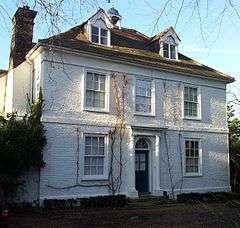
%3B_John_Joshua_Kirby_by_Thomas_Gainsborough.jpg)
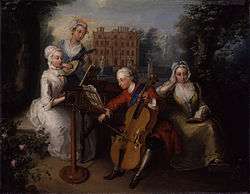
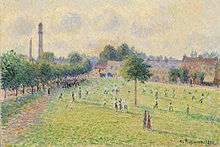
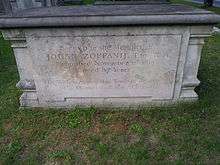
The Tudors and Stuarts
Charles Somerset, 1st Earl of Worcester, was granted lands at Kew in 1517. When he died in 1526 he left his Kew estates to his third wife, Eleanor, with the remainder to his son George. In 1538 Sir George Somerset sold the house for £200 to Thomas Cromwell, who resold it for the same amount to Charles Brandon, 1st Duke of Suffolk. Brandon had probably already inhabited Kew during the life of his wife Mary Tudor, the daughter of Henry VII and widow of the French king Louis XII. According to John Leland's Cygnea Cantio ("Swan Song"), she stayed in Kew (which he refers to as "Cheva")[12] for a time after her return to England.[13]
One of Henry VIII's closest friends, Henry Norris, lived at Kew Farm,[14] which was later owned by Elizabeth I's favourite, Robert Dudley, Earl of Leicester.[15] This large palatial house on the Thames riverbank predated the royal palaces of Kew Palace and the White House. Excavations at Kew Gardens in 2009 revealed a wall that may have belonged to the property.[16]
In Elizabeth's reign, and under the Stuarts, houses were developed along Kew Green.[17] West Hall, which survives in West Hall Road, dates from at least the 14th century and the present house was built at the end of the 17th century.[18]
Elizabeth Stuart, daughter of James I, was given a household at Kew in 1608.[13]
Queen Anne subscribed to the building of the parish church on Kew Green, which was dedicated to St Anne in 1714, three months before the Queen's death.[19]
The Hanoverians
The Hanoverians maintained the strongest links with Kew, in particular Princess Augusta who founded the botanic gardens[20] and her husband Frederick, Prince of Wales who lived at the White House in Kew. Augusta, as Dowager Princess of Wales, continued to live there until her death in 1721.[21] Frederick commissioned the building of the first substantial greenhouse at Kew Gardens.[22]
In 1761 the future George III and Queen Charlotte moved into the White House at Kew.[21] They established their main summer court at Kew from the 1760s and 1770s. Queen Charlotte died at the Dutch House in Kew in 1818.[21]
William IV spent most of his early life at Richmond and at Kew Palace, where he was educated by private tutors.[23]
Georgian expansion
During the French Revolution, many refugees established themselves in Kew, having built many of the houses of this period. In the 1760s and 1770s the royal presence attracted artists such as Thomas Gainsborough and Johann Zoffany.[13][24]
Artists associated with Kew
- Franz (later Francis) Bauer (1758–1840) was an Austrian microscopist and botanical artist who became the first botanical illustrator at Kew Gardens. By 1790 he had settled at Kew, where as well as making detailed paintings and drawings of flower dissections, often at microscopic level, he tutored Queen Charlotte, her daughter Princess Elizabeth and William Hooker in the art of illustration, and often entertained friends and botanists at his home. He is buried at St Anne's,[25] next to Thomas Gainsborough.
- The American-born English artist Walter Deverell (1827–1854), who was associated with the Pre-Raphaelite Brotherhood, lived at 352 Kew Road, then called Heathfield House. He had a studio at the end of the garden where there are now garages. In this setting he painted "The Pet".[26]
- George Engleheart (1750–1829), who was born in Kew,[27] was one of the greatest English painters of portrait miniatures.
- Thomas Gainsborough (1727–1788) visited Kew many times, staying with his friend Joshua Kirby and, after Kirby's death, in a house probably rented by his daughter close to St Anne's Church, where he is buried.[24]
- Arthur Hughes (1832–1915), Pre-Raphaelite painter, lived and died at Eastside House, 22 Kew Green, Kew.[28] The site is marked by a blue plaque.[29]
- Joshua Kirby (1716–1774) was a landscape painter, engraver, and writer, whose main artistic focus was "linear perspective", based on the ideas of English mathematician Brook Taylor.[30] He was the son of topographer John Kirby, and the father of the writer Sarah Trimmer and the entomologist William Kirby.[31] In 1760 he moved to Kew, where he taught linear perspective to George III.[32] He was a Fellow of the Royal Society.
- Sir Peter Lely (1618–1680), portrait painter, had a house on the north side of Kew Green.[33] On almost exactly the same site, Jeremiah Meyer (1735–1789), miniaturist to Queen Charlotte and George III, built a house a century later. Meyer is buried at St Anne's.[24]
- Charles Mozley (1914–1991), artist and art teacher, lived and died at 358 Kew Road, Kew.[34][35]
- Victorian artist Marianne North (1830–1890) did not live in Kew, but she left to Kew Gardens her collection of botanic art, painted on her extensive overseas travels, and funded a gallery – the Marianne North Gallery – to house them.[36]
- French Impressionist painter Camille Pissarro (1830–1903) stayed in 1892 at 10 Kew Green, on the corner of Gloucester Road, which is marked by a blue plaque.[37] During his stay he painted Kew Gardens – Path to the Great Glasshouse (1892), Kew Greens (1892) and Church at Kew (1892). His third son, Félix Pissarro (1874–1897), painter, etcher and caricaturist, died in a sanatorium at 262 Kew Road in 1897.[38]
- The painter Johann Zoffany (1725–1810), who lived at Strand-on-the-Green, is buried at St Anne's.[39]
Other notable inhabitants
Historical figures
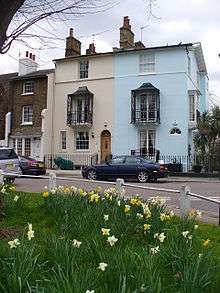
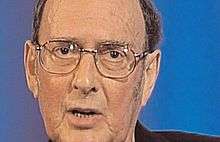
- William Aiton (1731–1793), botanist, was appointed director in 1759 of the newly established botanical garden at Kew, where he remained until his death. He effected many improvements at the gardens, and in 1789 he published Hortus Kewensis, a catalogue of the plants cultivated there.[nb 1] When he died, he was succeeded as director at Kew Gardens by his son William Townsend Aiton (1766–1849), who was also botanist, and was born in Kew.[40] William Townsend Aiton was one of the founders of the Royal Horticultural Society.[40] He retired in 1841 but remained living at Kew, although passing much of his time with his brother at Kensington where he died in 1849.[40] Both father and son lived at Descanso House on Kew Green and are buried in St Anne's churchyard[40][40] where the substantial family tomb is a prominent feature. Inside the church there is also a memorial to them.[41]
- David Blomfield (1934–2016), leader of the Liberal Party group on Richmond upon Thames Council, writer, book editor and local historian, lived in Kew.[42]
- Richard Cook (1957–2007), British jazz writer, magazine editor and former record company executive, was born in Kew.[43]
- Stephen Duck (c.1705–1756), poet, lived in Kew.[33]
- Prince Friso of the Netherlands (1968–2013), brother of King Willem-Alexander of the Netherlands, lived in Kew.[44]
- Liberal Party leader Jo Grimond (1913–1993) lived on Kew Green.[4][45]
- Sir William Hooker (1785–1865) and his son Sir Joseph Hooker (1817–1911), botanists and directors of Kew Gardens, lived at 49 Kew Green, Kew. The site is marked by a blue plaque.[46][47]
- Alfred Luff (1846–1933), English cricketer, was born in Kew.[48]
- Phil Lynott (1949–1986), Irish rock guitarist, songwriter, vocalist and leader of Thin Lizzy, lived in Kew.[49]
- Andrew Millar (1705–1768), Scottish bookseller, owned a country home on Kew Green.[50]
- Samuel Molyneux (1689–1728), Member of Parliament, and an amateur astronomer, who was married to Lady Elizabeth Diana Capel, the eldest daughter of the Earl of Essex, inherited Kew House on the death of Lady Capel of Tewkesbury.[51] Molyneux set up an observatory at the house and collaborated there with James Bradley in innovative designs for reflecting telescopes.[51] Kew House which later, as the White House, became the home of Prince Frederick and Princess Augusta, was pulled down in 1802 when George II's short-lived gothic "castellated palace" was built.[52]
- Desmond Morton (1891–1971), soldier, intelligence officer and personal assistant to Winston Churchill, 1940–45, lived at 22 Kew Green 1952–71.[53]
- Conrad Noel (1869–1942), Church of England priest and prominent British Christian socialist, was born in Royal Cottage, Kew Green.[54]
- Harold Pinter (1930–2008), playwright, dramatist, actor and director, lived at Fairmead Court, Taylor Avenue, Kew.[55]
- Sir Hugh Portman, 4th Baronet (died 1632), MP for Taunton, lived in a house opposite Kew Palace.[33]
- Sir John Puckering (1544–1596), lawyer, politician, Speaker of the English House of Commons, and Lord Keeper from 1592 until his death, lived in Kew.[33]
- Anthony Saxton (1934–2015), advertising executive and headhunter, lived at 3 Mortlake Road in Kew, and was a churchwarden of St Anne's Church, Kew.[56]
- John Stuart, 3rd Earl of Bute (1713–1792), botanist and honorary director of Kew Gardens, 1754–1772, adviser to Princess Augusta and tutor to George III and, later, Prime Minister of Great Britain (1762–63), lived at King's Cottage, 33 Kew Green.[57]
- Patrick Troughton (1921–1987), actor, most famous for playing the Second Doctor in the TV series Doctor Who, lived in Kew.[58]
- George Vassila (1857–1915), English cricketer, was born in Kew.[59]
Living people
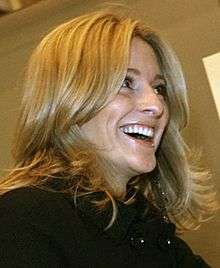
- Geoffrey Archer, fiction writer and former Defence Correspondent of ITN, lives in Kew.[60]
- Mick Avory, musician and former drummer with The Kinks, lives in Kew.[61]
- Nick Baird, group corporate affairs director of energy firm, Centrica, lives in Kew.
- Ray Brooks, actor, lives in Kew.[62]
- Justin Lee Collins, comedian and television presenter, lives in Kew.[63]
- Sir David Durie, former Governor of Gibraltar, lives in Kew.[64]
- Simon Fowler, social historian and author, lives in Kew.[65]
- Sir Donald Insall, architect, conservationist and author, lives in Kew.[66]
- Milton Jones, comedian, was brought up in Kew.[67]
- Gabby Logan, TV presenter, and her husband Kenny Logan, rugby player, live in Kew.[68]
- Serge Lourie, former Leader of Richmond upon Thames Council, and councillor for Kew for 28 years, lives in Kew.[69]
- Paul Ormerod, economist, lives in Kew.[70]
- Helen Sharman, the first British woman in space, lives in Kew[71]
- Jenny Tonge, Baroness Tonge, former MP, lives in Kew.[72]
- Sue Vertue, television producer, and her husband Steven Moffat, television writer and producer, live in Kew.[73][74]
Demography
In the ten years from the time of the 2001 census, the population rose from 9,445[75] to 11,436,[1] the sharpest ten-year increase in Kew since the early 20th century. This was partly accounted for by the conversion of former Thames Water land to residential use, and increases in property sizes. The figures are based on those for Kew ward,[75] the boundaries of the enlarged parish having been adjusted to allow for all wards in the borough to be equally sized.
Homes and households
| Ward | Detached | Semi-detached | Terraced | Flats and apartments | Caravans/temporary/mobile homes/houseboats | Shared between households[1] |
|---|---|---|---|---|---|---|
| Kew | 426 | 1,029 | 1,212 | 2,268 | 4 | 25 |
| Ward | Population | Households | % Owned outright | % Owned with a loan | Hectares[1] |
|---|---|---|---|---|---|
| Kew | 11,436 | 4,941 | 30 | 30 | 330 |
Ethnicity
The 2011 census showed that 66.2% of the population were White British. Other White was the second largest category at 16%, with 8.1% being Asian.[76]
Transport
A main mode of transport between Kew and London, for rich and poor alike, was by water along the Thames which, historically, separated Middlesex (on the north bank) from Surrey: Kew was also connected to Brentford, Middlesex by ferry, first replaced by bridge in 1759. The current Kew Bridge, which carries the South Circular Road (the A205) was opened by King Edward VII and Queen Alexandra in 1903.[21]
The A205 road commencing there passes through Kew as a single carriageway. However Kew Road provides the main road link to Richmond. The M4 motorway starts a short distance north of Kew, providing access to Heathrow Airport and the west. The A316 road starts in Chiswick and continues over Chiswick Bridge and a complex junction with the South Circular Road at Chalker's Corner at the south-eastern end of the district.
Since 1869 rail services have been available from Kew Gardens station. London Underground (District line) services run to Richmond and to central London. London Overground trains run to Richmond and (via Willesden Junction) to Stratford.
Three bus routes serve Kew: the 65, 391 and R68.[77]
River bus services supported by publicly funded Transport for London are from Kew Pier, to Richmond, Hampton Court and to Westminster Pier in central London.[78]
- Nearest places
- Nearest railway stations
- Kew Bridge station (South Western Railway)
- Kew Gardens station (London Overground; London Underground District line)
- North Sheen station (South Western Railway)
- Bridges
- Kew Bridge, which carries the A205 South Circular Road. Beside the bridge is Kew Pier, which serves tourist ferries operating under licence from London River Services.
- Kew Railway Bridge
Parks and open spaces
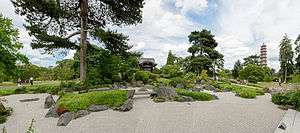
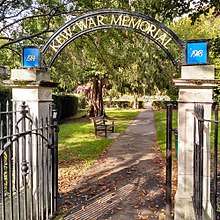
- Kew Green is used by Kew Cricket Club for cricket matches in the summer.
- Kew Pond, near the northeast corner of Kew Green, believed to date from the tenth century,[79][80] is originally thought to have been a natural pond fed from a creek of the tidal Thames. During high (spring) tides, sluice gates are opened to allow river water to fill the pond via an underground channel. The pond is concreted, rectangular in shape and contains an important reed bed habitat which is vital for conservation and resident water birds. The pond is managed in partnership with the Friends of Kew Pond.[81]
- North Sheen Recreation Ground in Dancer Road, known locally as "The Rec", was originally part of an orchard belonging to the Popham Estate, owned by the Leyborne Pophams whose family seat was at Littlecote House, Wiltshire. Opened in June 1909 and extended in 1923, it now contains football pitches, a running track, a children's paddling pool, two extensive playgrounds, a large dog-free grassed area and a pavilion set amongst trees and shrubs.[82] It is also the home of a local football club, Kew Park Rangers. A new £1 million sports pavilion[83] was opened in September 2011.[84]
- Pensford Field,[85] previously playing fields of the former Gainsborough School, is now a nature reserve and also the home of Pensford Tennis Club.
- St Luke's Open Space, a quiet sitting area and toddlers' play area, was previously a playground for a former Victorian primary school.[86][nb 2]
- Westerley Ware is at the foot of Kew Bridge. It was created as a memorial garden to the fallen in the First World War, and also has a grass area, three hard tennis courts and a children's playground. Its name refers to the practice of netting weirs or "wares" to catch fish.[87][88]
Sport and leisure
Kew's several other sports clubs include:
- North Sheen Bowling Club on Marksbury Avenue[89]
- Priory Park Club on Forest Road – tennis and (until 2017) bowls[90][91]
- Putney Town Rowing Club on Townmead Road
- Richmond Gymnastics Association on Townmead Road[92]
The nearest football club in the Football League is Brentford FC, approximately one mile away.
Societies
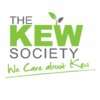 | |
| Motto | We care about Kew |
|---|---|
| Formation | 1901 (as the Kew Union)[93] |
| Legal status | registered charity |
Membership | 800 |
Chair | Roger Mason |
Main organ | The Kew Society Newsletter |
Budget | £30,000[94] |
Staff | none |
| Website | www |
The Kew Horticultural Society, founded in 1938, organises an annual show in late August/early September[95][96][97] as well as talks, events and outings throughout the year.
The Kew Society, founded in 1901 as the Kew Union,[93] is a civic society that seeks to enhance the beauty of Kew and preserve its heritage. It reviews all planning applications in Kew with special regard to the architectural integrity and heritage of the neighbourhood, and plays an active role in the improvement of local amenities. The Society, which is a member of Civic Voice,[98] organises community events including lectures and outings and produces a quarterly newsletter.
The Richmond Local History Society is concerned with the history of Kew, as well as Richmond, Petersham and Ham.[99]
Education
.jpg)
Primary schools
- Darell Primary and Nursery School is on Darell Road and Niton Road. It opened in 1906, as the Darell Road Schools, at the southern end of what had been the Leyborne-Popham estate.[100] Darell School was Richmond Borough Council's first primary school and was built in the "Queen Anne" style, in brick with white stone facings. Although it has been extended several times, it is now the only Richmond primary school still in its historic original pre-1914 building.[101]
- Kew Riverside Primary School, on Courtlands Avenue, opened in 2003.[102]
- The Queen's Church of England Primary School is in Cumberland Road, where it moved in 1969.[103] In her will of 1719, Dorothy, Lady Capel of Kew House left to four trustees Perry Court Farm in Kent, which she had inherited from her father. One twelfth of the rent from the farm was to be given to St Anne's Church to establish a school in Kew.[104] In 1810, a "Free School" was opened in the church for 50 children, financed by subscribers who gave one guinea a year, in addition to a contribution by King George III. In 1824 the school moved to a site near the pond on Kew Green. The foundation stone was laid on 12 August, the birthday of King George IV, who gave £300 on condition that it be called "The King's Free School". Queen Victoria gave permission for it to be called "The Queen's School" and decreed that its title should change with that of the monarch.[103]
Independent preparatory schools
- Broomfield House School, on Broomfield Road, was founded in 1876.[105]
- Kew College, a co-educational school for 3–11 year olds, was founded in 1927 by Mrs Ellen Upton in rooms over a shop in Kew. Mrs Upton's young daughter was one of the first pupils. The school later moved to Cumberland Road. In 1953, Mrs Upton retired and sold the school to Mrs Hamilton-Spry who, in 1985, handed over the buildings to a charitable trust to ensure the school's long term continuity.
- Kew Green Preparatory School, at Layton House, Ferry Lane, near Kew Green, opened in 2004.
- Unicorn School, established in 1970, is a co-educational, parent-owned school on Kew Road, opposite Kew Gardens.
Places of worship
Five churches in Kew are currently in use:
| Name | Denomination/affiliation | History | Address | Website | Image |
|---|---|---|---|---|---|
| Kew Baptist Church | Grace Baptist | Founded in 1861 in Richmond as Salem Baptist Church, it moved in 1973 to a new building in Kew and adopted its current name in 1990. | 2a Windsor Road, Richmond TW9 2EL | www |  |
| Our Lady of Loreto and St Winefride's, Kew | Roman Catholic | From 1890 to 1906 local Roman Catholics met in a temporary chapel at a Catholic mission on Kew Gardens Road. Designed by the architects Scoles & Raymond, the new church was opened in 1906 and the side aisles, baptistery and chapels were added in 1968. The sanctuary was remodelled in 1977 and the church was refurbished and decorated in 1998. A parish hall is located next to the church. After a parishioner's bequest paid off the church's debts, the church was dedicated and consecrated in 1979. | 1 Leyborne Park, Kew, Richmond TW9 3HB | www | 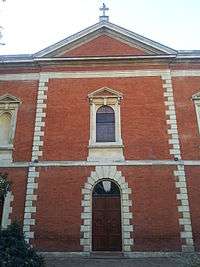 |
| St Anne's Church, Kew | Anglican | Built in 1714 on land given by Queen Anne, the church, now Grade II* listed, has been extended several times. The present parish hall was built in 1978. The churchyard has two Grade II* listed monuments – the tombs of the artists Johan Zoffany (d. 1816) and Thomas Gainsborough (d. 1788). | Kew Green, Kew, Richmond TW9 3AA | www | 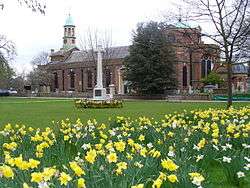 |
| St Luke's Church, Kew | Anglican | Founded in 1889, St Luke's now forms a joint parish with the Barn Church (below). The church, built in the Gothic Revival style by architects Goldie, Child and Goldie, was redesigned in 1983 to create a smaller space for Christian worship in the former chancel area and to enable the former nave, and a second hall constructed in a loft conversion, to be used for community purposes also: it now hosts the Kew Community Trust and acts as a community centre. | The Avenue, Kew, Richmond TW9 2AJ | www | 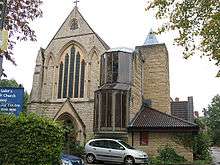 |
| St Philip and All Saints Church, Kew (the Barn Church) | Anglican | Founded in 1929, this was the first barn church to be consecrated in England. Local Anglicans previously worshipped at St Peter's, a hall erected in 1910 (and now demolished) on the corner of Marksbury Avenue and Chilton Road. The church building was constructed in 1929 from a 17th- (or possibly 16th-) century barn from Oxted in Surrey. The west end was converted in 2002 into a large parish room with a gallery above looking down the length of the building. The sanctuary was refurbished and remodelled in 1998. | Atwood Avenue, Kew, Richmond TW9 4HF | barnchurchkew | 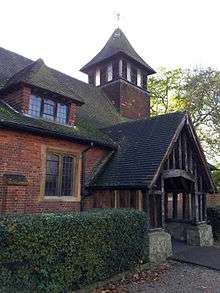 |
Former churches include the late 19th-century Cambridge Road Wesleyan Methodist Chapel, previously known as the Gloucester Road Wesleyan Methodist Chapel[106] and also known as Cambridge Road Methodist Church,[107] which was in use from 1891 to 1969.[107] A late Victorian Salvation Army hall at 6 North Road, built in the style of a chapel, was converted into flats (1–5 Quiet Way) in the early 21st century.[108]
Cemeteries and crematorium
Mortlake Crematorium and two cemeteries – North Sheen Cemetery and Mortlake Cemetery – are located in Kew.[109]
Literary references to Kew
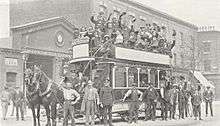
I am His Highness' dog at Kew;
Pray tell me, sir, whose dog are you?
- Epigram, engraved on the Collar of a Dog which I gave to his Royal Highness (Frederick, Prince of Wales), 1736[110] (Alexander Pope, 1688–1744)
And the wildest dreams of Kew are the facts of Khatmandhu
- In The Neolithic Age, 1892 (Rudyard Kipling, 1865–1936)
Go down to Kew in lilac-time, in lilac-time, in lilac-time;
Go down to Kew in lilac-time (it isn't far from London!)
And you shall wander hand in hand with love in summer's wonderland;
Go down to Kew in lilac-time (it isn't far from London!)
- The Barrel-Organ, 1920 (Alfred Noyes, 1880–1958)
Trams and dusty trees.
Highbury bore me. Richmond and Kew
Undid me.
- The Waste Land, 1922 (T. S. Eliot, 1888–1965)
Lady Croom: My hyacinth dell is become a haunt for
hobgoblins, my Chinese bridge, which I am assured is
superior to the one at Kew, and for all I know at Peking, is
usurped by a fallen obelisk overgrown with briars.
- Arcadia, 1993 (Tom Stoppard, b. 1937)
See also
Notes
-

- The former building of St Luke's School is now an art studio."Kew Studio". 24 January 2013. Retrieved 10 October 2017.
References
- Key Statistics; Quick Statistics: Population Density Office for National Statistics
- "History of Kew, in Richmond upon Thames and Surrey". A Vision of Britain through Time. GB Historical GIS / University of Portsmouth. Retrieved 3 June 2014.
- Blomfield 1994, p.3
- Blomfield 1994, p.131
- Blomfield, David. The Story of Kew, second edition, p.36, Leyborne Publications, 1996, ISBN 0 9520515 2 4
- Room, Adrian. Dictionary of Place-Names in the British Isles, Bloomsbury, 1988, ISBN 978-0747501701
- Great Britain Historical GIS / University of Portsmouth, Richmond MB (historic map). Retrieved 21 November 2009.
- Meyer-Stabley, Bertrand (2016). Kate Middleton: La vie de Catherine, Duchesse de Cambridge. Paris: La Boite a Pandore. ISBN 978-2-39009-130-1.
- "Caxton Name Plate Manufacturing Company Limited". Duedil. Retrieved 3 March 2018.
- Amies, Mark (17 November 2015). "London's Lost Manufacturing – We Were Once The British Detroit". Londonist. Retrieved 4 February 2016.
- Stevens-Stratten, S W (1983). British Lorries 1945–1983 (2nd, revised ed.). Littlehampton Book Services Ltd. ISBN 978-0711013001.
- Leland, John, (translated by Sutton, Dana F) (1545). "Cygnea Cantio". Cygnea Cantio (Swan Song). The Philological Museum. Retrieved 18 October 2012.CS1 maint: multiple names: authors list (link)
- Malden, H E (editor) (1911). "Parishes: Kew". A History of the County of Surrey: Volume 3. London. pp. 482–487. Retrieved 18 October 2012.CS1 maint: extra text: authors list (link)
- Blomfield 1994, p.5
- Blomfield 1994, p.12
- "Replacement children's play area: land adjacent to the Climbers and Creepers Building, Royal Botanic Gardens, Kew: an archeological evaluation" (PDF). Compass Archaeology. September 2009. pp. i and 4. Retrieved 18 October 2012.
- Blomfield 1994, p.16
- Blomfield 1994, p.18
- Blomfield 1994, p.23
- "Reading the Royal Landscape: Heritage Year 2006" (Press release). Royal Botanic Gardens Kew. 2006. Archived from the original on 5 February 2016. Retrieved 4 February 2016.
- "Royal Richmond timeline:900 years of royal associations with Richmond upon Thames". Local history timelines. London Borough of Richmond upon Thames. 23 July 2012. Retrieved 5 July 2020.
- Blomfield 1994, p.32
- Zeigler, Philip (1971). King William IV. London: Collins. pp. 13–19. ISBN 978-0-00-211934-4.
- Blomfield 1994, pp.43–45
- "St Anne's Church, Kew Green" (PDF). Local History Notes. London Borough of Richmond upon Thames. Retrieved 18 December 2012.
- Blomfield 1994, p.95
- "Penelope Blathwayt, Mrs Jeremiah Pierce Crane (1755–1810): George Engleheart (Kew 1750 – Blackheath 1839) National Trust Inventory Number 453454". National Trust Collections. National Trust. Archived from the original on 5 September 2014. Retrieved 10 October 2017.
- Riggs, Terry (November 1997). "Arthur Hughes: artist biography". Tate. Retrieved 16 February 2020.
- "Blue Plaques in Richmond upon Thames". Visit Richmond. London Borough of Richmond upon Thames. Retrieved 10 October 2017.
- See a short literary biography of Joshua Kirby in Gentleman's Magazine (ed. John Nichols) Vol. 78, January 1808, pp. 4–5.
- Freeman, John (1852). Life of the Rev William Kirby MA. London: Longman, Brown, Green & Longmans. Retrieved 11 July 2017.
- John Joshua Kirby in the RKD (Netherlands Institute for Art History). Retrieved 24 December 2018.
- Lysons, Daniel (1792). "Kew". The Environs of London: volume 1: County of Surrey. Centre for Metropolitan History. pp. 202–211. Retrieved 17 October 2012.
- "Charles Mozley – details". The Collection. British Museum. Retrieved 23 May 2016.
- Historic England. "356 and 358 Kew Road (1357700)". National Heritage List for England. Retrieved 22 December 2016.
- Blomfield 1994, p.96
- "Pissarro's home on Kew Green". Community Archive. London Borough of Richmond upon Thames. Archived from the original on 17 October 2013. Retrieved 30 May 2017.
- Reed, Nicholas (1997). Pissarro in West London (Kew, Chiswick and Richmond) (Fourth ed.). Lilburne Press. p. 46. ISBN 978-1-901167-02-3.
- Blomfield 1994, p.45
- Britten, James (1885–1900). "Aiton, William Townsend (1766–1849) (DNB00)". Dictionary of National Biography. Retrieved 16 January 2013.
- Royal Gardeners at Kew – The Aitons. Richmond Local History Society. 2009. ISBN 9780955071751. Retrieved 27 December 2018.
- Grossman, Wendy (22 August 2016). "David Blomfield obituary". The Guardian. Retrieved 16 July 2017.
- Morton, Brian (1 September 2007). "Richard Cook: Jazz writer and editor". The Independent. London. Retrieved 11 January 2013.
- Keleny, Anne (13 August 2013). "Prince Johan Friso Obituary: Popular royal who ceded his place in line to the Dutch throne". The Independent. London. Retrieved 13 August 2013.
- Meadowcroft, Michael (December 1993). "Jo Grimond: an appreciation" (PDF). Liberator: 12.
- "Hooker, Sir Joseph (1817–1911) & Hooker, Sir William (1785–1865)". Blue Plaques. English Heritage. Retrieved 22 December 2016.
- "Princess Alexandra unveils blue plaque to Kew Gardens' directors Sir William and Sir Joseph Hooker". Richmond and Twickenham Times. 30 July 2010. Retrieved 22 December 2016.
- "Alfred Luff". CricketArchive. Retrieved 11 January 2013.
- Faulkner, Scott (August 2009). "Phil Lynott remembered". BBC Birmingham. Retrieved 11 October 2012.
- "Letter from Andrew Millar to Andrew Mitchell, 26th August 1766". Circulating Enlightenment. AHRC Millar Project, University of Edinburgh. Retrieved 13 May 2019.
- O'Connor, J J; Robertson, E F (December 2008). "Samuel Molyneux". School of Mathematics and Statistics, University of St Andrews, Scotland. Retrieved 18 October 2012.
- "Archive record: Kew House, otherwise Kew Palace: Lease, 1759 Reference Number: 553". Exploring Surrey's Past. Surrey History Centre. 16 August 1759. Retrieved 18 October 2012.
- Bennett, Gill (2006). Churchill's Man of Mystery: Desmond Morton and the World of Intelligence. Routledge. ISBN 9780415394307.
- Heywood, Andrew (1996). "Gustav Holst, William Morris and the Socialist Movement" (PDF). The Journal of the William Morris Society. 11 (4): 39–47. ISSN 0084-0254. Retrieved 22 April 2018.CS1 maint: ref=harv (link)
- Baker, William (22 November 2013). A Harold Pinter Chronology. Palgrave Macmillan. p. 109. ISBN 978-1-137-38432-4.
- "Saxton Bamphylde Hever Limited". Companies House. Retrieved 20 September 2018.
- Gascoigne, Bamber and contributors (2001). "HistoryWorld's Places in History: Kew Green". HistoryWorld. Retrieved 19 October 2012.
- Troughton, Michael. "Life depends on Change and Renewal". Extracts from Biography. Archived from the original on 11 October 2016. Retrieved 11 October 2016.
- "George Vassila". CricketArchive. Retrieved 11 January 2013.
- Brockes, Emma (23 July 2001). "Archer: the interview". The Guardian. Retrieved 7 April 2014.
- Ambrose, Tom (22 February 2014). "Original Kinks drummer Mick Avory returns to Twickenham Eel Pie Club". Richmond and Twickenham Times. Retrieved 22 February 2014.
- "Interview With Ray Brooks, Voice Of Mr Benn, Lover Of Chiswick And Resident Of Kew". Chiswick Herald. 29 November 2012. Retrieved 25 May 2016.
- "Justin Lee Collins 'kept girlfriend's sexual history'". BBC News. 26 September 2012. Retrieved 26 September 2012.
- "Sir David Durie". History & Today. The Durie Family. Archived from the original on 29 November 2014. Retrieved 9 May 2014.
- "Who we are". Richmond Local History Society. Retrieved 27 December 2018.
- Fleming, Christine (20 June 2010). "Richmond residents on Queen's Birthday Honours List". Richmond and Twickenham Times. Retrieved 27 June 2017.
- Moore, Cliff (3 October 2011). "Milton Jones, Bournemouth Pavilion". Bournemouth Daily Echo. Retrieved 9 October 2012.
- Conway, Juliet (12 October 2012). "Gabby Logan's My London". Evening Standard magazine. London. Retrieved 14 January 2016.
- "Alexander Serge LOURIE". Companies House. Retrieved 8 October 2017.
- Ormerod, Paul (2 December 1993). "Letter: Kenneth Clarke's Budget: taxes, consumer spending, unemployment and Canada's Tories". The Independent. Retrieved 30 January 2016.
- Sharman, Helen (April 2020). "Thoughts from space". TW9. Retrieved 28 April 2020.
- Tonge, Jenny (16 April 2010). "Volcano's shadow may fall on UK ecomony [sic], but not on Heathrow flight path". The Guardian. London. Retrieved 19 February 2017.
- Sternbergh, Adam (7 September 2003). "Selling your Sex Life". The New York Times. Retrieved 18 November 2015.
- Jeffries, Stuart (20 January 2012). "'There is a clue everybody's missed': Sherlock writer Steven Moffat interviewed". The Guardian. Retrieved 3 January 2014.
- "Statistics from the 2001 Census of Population for Kew Ward" (PDF). London Borough of Richmond upon Thames. 23 August 2005. Archived from the original (PDF) on 17 October 2013. Retrieved 12 June 2013.
- "UK Census Data – Kew". Retrieved 16 May 2016.
- "Buses from Kew Gardens" (PDF). Transport for London. 20 October 2018. Retrieved 14 May 2019.
- "Thames River Boats to Kew, Richmond and Hampton Court". Westminster Passenger Services Association. Archived from the original on 22 December 2012. Retrieved 12 January 2013.
- Adams, Mike; Dunrossil, Diana. "The History of Kew Pond" (PDF). The Kew Society. Retrieved 7 October 2017.
- "The History of Kew Pond" (PDF). Kew Society Newsletter. Autumn 2017. p. 4. Retrieved 8 October 2017.
- "Kew Pond". richmond.gov.uk. Archived from the original on 14 February 2017. Retrieved 13 February 2017.
- "North Sheen Recreation Ground". London Borough of Richmond upon Thames. Retrieved 8 October 2017.
- Mason, Ian (26 September 2009). "Work kicks off on £1 million sports pavilion for North Sheen Recreation Ground". Richmond and Twickenham Times. Retrieved 18 November 2015.
- Fleming, Christine (8 September 2011). "Delight as new pavilions finally ready". Richmond and Twickenham Times. Retrieved 18 November 2015.
- "Pensford Field". Pensford Field Environmental Trust. Retrieved 14 January 2016.
- "St Luke's Open Space". London Borough of Richmond Upon Thames. Retrieved 8 October 2017.
- "Westerley Ware Recreation Ground". London Borough of Richmond upon Thames. Retrieved 8 October 2017.
- "Westerley Ware". London Gardens Online. London Parks and Gardens Trust. 1 November 2010. Retrieved 2 December 2013.
- "Contact Us". North Sheen Bowling Club. Retrieved 3 February 2015.
- "113-year-old Priory Park bowls club in Kew has closed". Richmond and Twickenham Times. 5 October 2017. Retrieved 8 October 2017.
- "Welcome to Priory Park Club". Priory Park Club. Retrieved 3 February 2015.
- "Home". Richmond Gymnastics Association. Retrieved 3 February 2015.
- Blomfield, 1994, p.112 and p.131
- "Documents for the year ending 31 July 2019: Annual report 2019". The Kew Society. October 2019. Retrieved 20 June 2020.
- "History". Kew Horticultural Society. Retrieved 2 December 2013.
- "Summer Show". Kew Horticultural Society. Retrieved 22 December 2016.
- Gupta, Lila Das (28 August 2004). "When the country comes to town". The Daily Telegraph. Retrieved 19 May 2014.
- "The Kew Society". Civic Voice. Retrieved 21 March 2015.
- "Find charities". Charity Commission. Retrieved 6 November 2013.
- Blomfield 1994, pp.114–115
- "History". Darell Primary and Nursery School. Retrieved 18 November 2015.
- "Kew Riverside Story". Kew Riverside Primary School. Archived from the original on 19 September 2016. Retrieved 25 May 2016.
- "Queen's History in Kew". The Queen's School Kew. Retrieved 18 October 2012.
- "The Queen's School, Kew: Records". Exploring Surrey's Past. Surrey History Centre archives. Retrieved 28 May 2017.
- "The Early Years". Broomfield House School. Retrieved 1 November 2015.
- "Cambridge Road Wesleyan Methodist Chapel (Kew, Surrey): Church records, 1892–1902". Family History Library Catalog. The Church of Jesus Christ of Latter-day Saints. Archived from the original on 8 August 2014. Retrieved 23 April 2013.
- "Cambridge Road Methodist Church, Kew GB/NNAF/C6825 (Former ISAAR ref: GB/NNAF/O83449) – 1891–1969: minutes, baptism register and misc papers". National Register of Archives. The National Archives (UK). Retrieved 23 April 2013.
- "Site at Salvation Army Hall, North Road, Richmond TW9 4HA" (PDF). Appeal Decision. The Planning Inspectorate. 29 November 2006. Retrieved 29 April 2019.
- "Character Area 10:Character Area 10: Mortlake Road/North Sheen Cemetery/Mortlake Crematorium" (PDF). Kew Village Planning Guidance. London Borough of Richmond upon Thames. February 2014. p. 36. Archived from the original (PDF) on 4 October 2015. Retrieved 27 June 2017.
- Thomas, W K (April 1969). "His Highness' Dog at Kew". College English. 30 (7): 581–586. doi:10.2307/374007. JSTOR 374007.
Sources
- Blomfield, David (1994). Kew Past, Chichester, Sussex: Phillimore & Co. Ltd. ISBN 0-85033-923-5
Further reading
- Blomfield, David (2011). The Story of Kew (5th, enlarged, edition). London: Leyborne Publications. ISBN 978-0-9520515-3-4.
- Blomfield, David; May, Christopher (2016). Kew at War 1939–1945 (3rd edition). London: Richmond Local History Society. ISBN 978-0-9550717-4-4.
- Cloake, John (1995). The Palaces and Parks of Richmond and Kew 1: The Palaces of Shene and Richmond. Chichester: Phillimore & Co Ltd. ISBN 978-0850339765. OCLC 940979634.
- Cloake, John (1996). The Palaces and Parks of Richmond and Kew 2: Richmond Lodge and the Kew Palaces. Chichester: Phillimore & Co Ltd. ISBN 978-1860770234. OCLC 36045530. OL 8627654M.
- Cloake, John (2001). Cottages and Common Fields of Richmond and Kew. Chichester: Phillimore & Co Ltd. ISBN 978-1860771958.
- Members of the Richmond Local History Society (2019). The Streets of Richmond and Kew (3rd edition). London: Richmond Local History Society. ISBN 978-1912-314010.
- Walford, Edward (1883). "Kew". Greater London: a narrative of its history, its people, and its places. London: Cassell & Co. OCLC 3009761.
External links
| Wikimedia Commons has media related to Kew, London. |
| Wikisource has the text of the 1911 Encyclopædia Britannica article Kew. |
| Wikivoyage has a travel guide for London/Richmond-Kew. |

